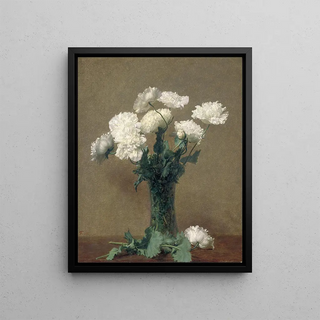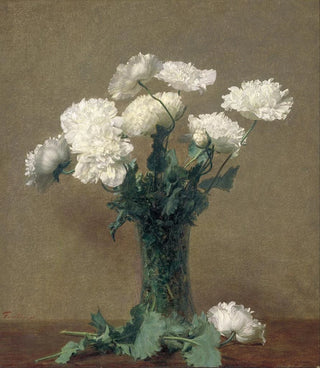Art print | Poppies - Henri Fantin-Latour


View from behind

Frame (optional)
Coquelicots - Henri Fantin-Latour – Captivating Introduction
In the art world, certain works transcend their era and become symbols of a unique aesthetic sensibility. "Coquelicots - Henri Fantin-Latour" is undoubtedly one of these creations. This canvas, vibrant with colors and emotions, transports us to a universe where the beauty of nature is highlighted with rare delicacy. Contemplating this piece, the viewer is immediately struck by the freshness of the poppies that seem to dance under the light, offering an invitation to reflection and wonder. The art print of this work allows you to relive this aesthetic experience while paying tribute to the virtuosity of its creator.
Style and uniqueness of the work
The style of "Coquelicots" is emblematic of the Impressionist movement, although Fantin-Latour was often associated with more classical techniques. The composition of the piece is both simple and complex, with flowers arranged to capture light and play with shadows. The poppies, in a brilliant red, stand out against a soft, blurred background, creating a striking contrast that draws the eye. Fantin-Latour's painting technique, which blends realism and impressionism, gives the work an almost poetic atmosphere. Each petal seems to be alive with its own life, while the treatment of colors evokes lightness and the fleeting nature of the outdoors. This painting, with its apparent simplicity, reveals a depth of emotion that touches the soul.
The artist and his influence
Henri Fantin-Latour, born in 1836, is a significant figure in the French art scene of the 19th century. Although he is often less celebrated than some of his contemporaries, his work had a substantial influence on the development of impressionism. Fantin-Latour mastered capturing the essence of flowers with such finesse that he inspired many artists to explore nature from a new perspective. His ability to combine technique and emotion made him a master in the field of still life. Through his paintings, he contributed to redefining the perception of beauty, highlighting

Matte finish

View from behind

Frame (optional)
Coquelicots - Henri Fantin-Latour – Captivating Introduction
In the art world, certain works transcend their era and become symbols of a unique aesthetic sensibility. "Coquelicots - Henri Fantin-Latour" is undoubtedly one of these creations. This canvas, vibrant with colors and emotions, transports us to a universe where the beauty of nature is highlighted with rare delicacy. Contemplating this piece, the viewer is immediately struck by the freshness of the poppies that seem to dance under the light, offering an invitation to reflection and wonder. The art print of this work allows you to relive this aesthetic experience while paying tribute to the virtuosity of its creator.
Style and uniqueness of the work
The style of "Coquelicots" is emblematic of the Impressionist movement, although Fantin-Latour was often associated with more classical techniques. The composition of the piece is both simple and complex, with flowers arranged to capture light and play with shadows. The poppies, in a brilliant red, stand out against a soft, blurred background, creating a striking contrast that draws the eye. Fantin-Latour's painting technique, which blends realism and impressionism, gives the work an almost poetic atmosphere. Each petal seems to be alive with its own life, while the treatment of colors evokes lightness and the fleeting nature of the outdoors. This painting, with its apparent simplicity, reveals a depth of emotion that touches the soul.
The artist and his influence
Henri Fantin-Latour, born in 1836, is a significant figure in the French art scene of the 19th century. Although he is often less celebrated than some of his contemporaries, his work had a substantial influence on the development of impressionism. Fantin-Latour mastered capturing the essence of flowers with such finesse that he inspired many artists to explore nature from a new perspective. His ability to combine technique and emotion made him a master in the field of still life. Through his paintings, he contributed to redefining the perception of beauty, highlighting






